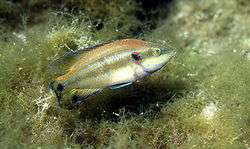Ocellated wrasse
| Ocellated wrasse | |
|---|---|
.jpg) | |
| Scientific classification | |
| Kingdom: | Animalia |
| Phylum: | Chordata |
| Class: | Actinopterygii |
| Order: | Perciformes |
| Suborder: | Labroidei |
| Family: | Labridae |
| Subfamily: | Labrinae |
| Genus: | Symphodus |
| Species: | S. ocellatus |
| Binomial name | |
| Symphodus ocellatus (Linnaeus, 1758) | |
| Synonyms | |
| |
The ocellated wrasse (Symphodus ocellatus) is a species of wrasse native to the eastern Atlantic Ocean and throughout the Mediterranean Sea, the Black Sea, and the Sea of Azov. It inhabits areas with rocks and eelgrass at depths from 1 to 30 m (3.3 to 98.4 ft). It feeds on various marine invertebrates. This species can reach 12 cm (4.7 in) in standard length. It can also be found in the aquarium trade.[2]

These fish live about two to three years. They are cleaner fish, which means they help remove parasites, bacteria and other items off of larger fish of a different species. There are three distinct male forms. There are nesting males, sneaker males, and satellite males. The nesting males are the largest of the three and the most brightly colored. The sneaker males are the smallest of the three types and the most dull in color, and actually closely resemble the female phenotype. Satellite males are an intermediate in size and color between the large nesting male and smaller sneaker male. Nesting males court females, build and guard nests, and provide parental care for the offspring. Nests are made of harvested algae. Sneaker males do not court females, do not provide parental care and they join in when a female and nesting male are mating in an attempt to fertilize the eggs before the nesting male. Satellite males assist in courting the females, they chase away sneaker males, but they do not provide parental care for the offspring. The male types are determined in early development. If a male fish grows quickly, it will be a satellite male in its first breeding season then will become a nesting male in its' second. For the slower growing males, they will be a sneaker male in their first breeding season, then a satellite male in their second. Breeding season occurs from May to June.[3]
References
- ↑ Pollard, D. 2010. Symphodus ocellatus. In: IUCN 2013. IUCN Red List of Threatened Species. Version 2013.1. www.iucnredlist.org. Downloaded on 17 November 2013.
- ↑ Froese, Rainer and Pauly, Daniel, eds. (2013). "Symphodus ocellatus" in FishBase. October 2013 version.
- ↑ Alonzo, S. H. et. al.
Alonzo, S. H. et al. Ovarian fluid allows directional cryptic female choice despite external fertilization. Nat. Commun. 7:12452 doi: 10.1038/ncomms12452 (2016).
External links
| Wikimedia Commons has media related to Symphodus ocellatus. |
